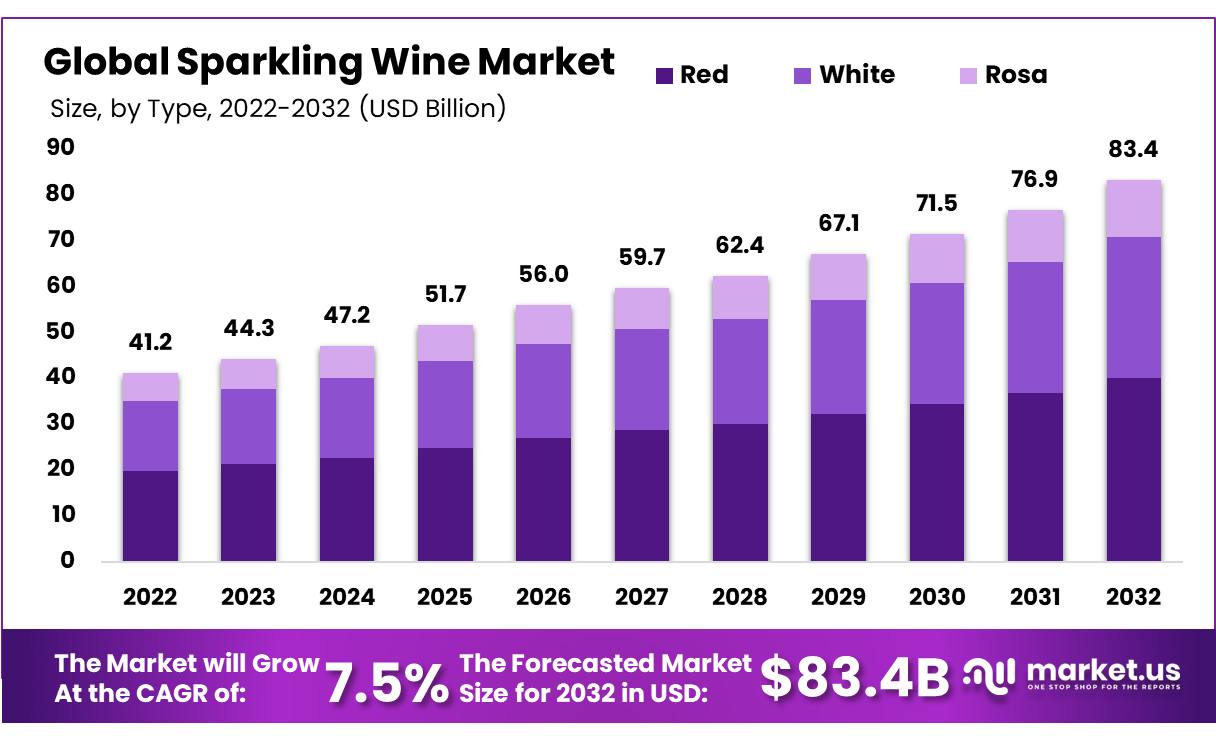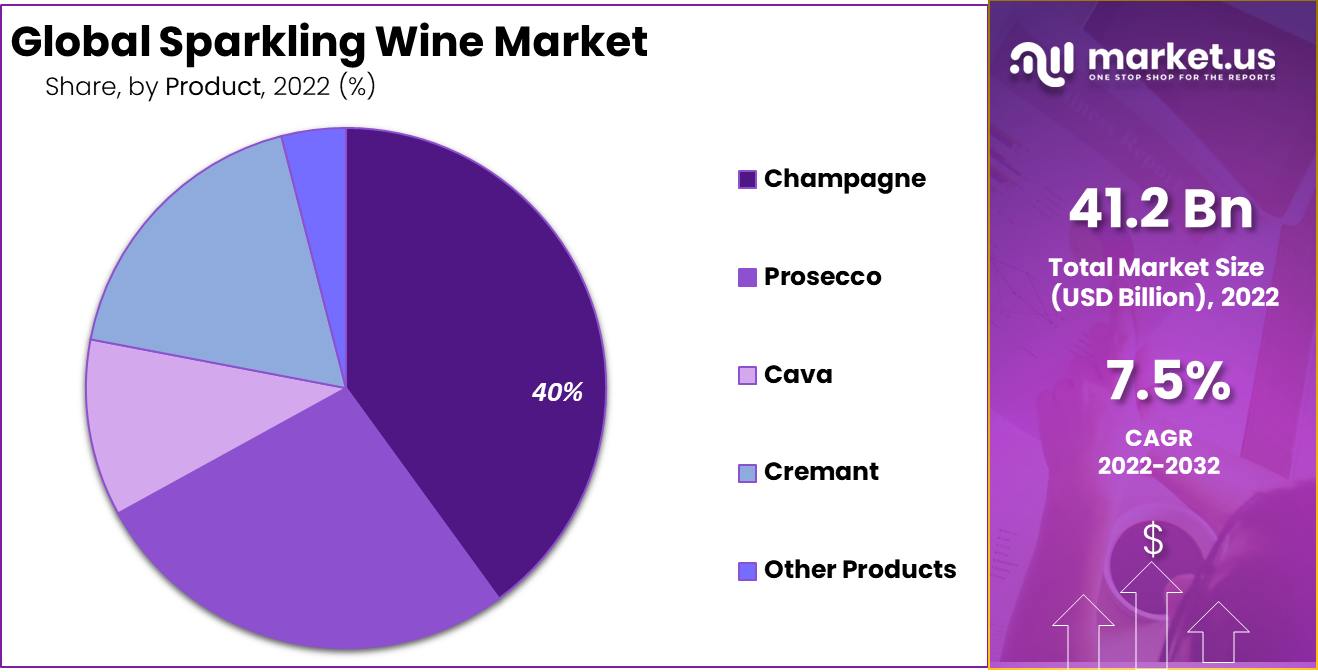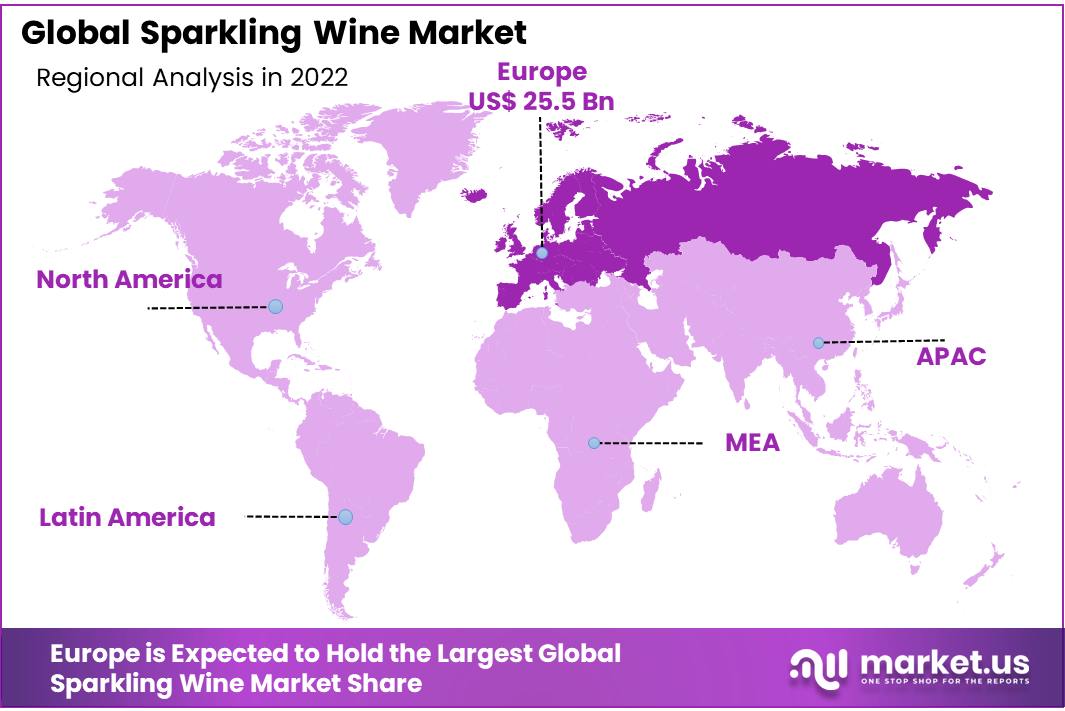Global Sparkling Wine Market By Type (Red, Rose, White), By Product (Cava, Champagne, Cremant, Prosecco, Other Products), By Distribution Channels (Bar, Pubs & Restaurants, Supermarket/Hypermarket, Liqiour Stores, Online Retail, Other Distribution Channels), By Region and Companies - Industry Segment Outlook, Market Assessment, Competition Scenario, Trends and Forecast 2023-2032
- Published date: Sep 2023
- Report ID: 106909
- Number of Pages: 355
- Format:
- keyboard_arrow_up
Quick Navigation
Report Overview
In 2022, the Global Sparkling Wine Market was valued at USD 41.2 Billion, and it is projected to reach USD 83.4 billion by 2032 from 2023 to 2032, this market is estimated to register a CAGR of 7.5%.
Sparkling wine is a fermented carbonated beverage made with grapes and other ingredients. The fermentation manner results in the production of alcohol and CO2. During fermentation, the gas is not allowed to get away, so tiny bubbles form.
This carbonation of wine takes place either in bottles or huge tanks. Carbonation can also result from CO2 injected into some forms of wines. As living standards are increasing globally, customers’ aspiration to consume sparkling wine is likewise expected to grow.
The consumption of Sparkling Wine is regularly related to occasions consisting of celebrations. Furthermore, product dependency on those merchandise at marriages, events, and social gatherings will drive the market boom in the coming years.
Key Factors
- With a market share of 48%, red wine has the largest market share in the global sparkling wine market because of its health benefits, premiumization, and flavor.
- Champagne holds the largest market share, 40%, in the sparkling wine market because it is associated with celebrations and special occasions.
- The supermarkets/hypermarkets segment holds the largest share.
- Rising health consciousness among consumers drives the growth of the sparkling wine market.
- Increasing alcohol socializing among consumers is helping the sparkling wine market grow.
- The high costs associated with producing sparkling wine hamper the growth of the sparkling wine market.
- Europe region holds a significant share of the global sparkling wine market.
- Between 2019 and 2022, the number of Americans drinking sparkling wine rose by 30%, with the number of monthly sparkling wine drinkers rising from 56% three years ago to 72% in 2022.

Actual Numbers Might Vary in the final report
Market Scope
Type Analysis
Red Wine Owns the Largest Market Share in the Global Sparkling Wine Market because of its health benefits, premiumization, and flavor.
The global sparkling wine market is segmented into red, rose, and white based on type. Among these, red wine held the largest wine market share at 48%. The red segment is driven by increasing demand for wine due to its health benefits, premiumization of wine merchandise, innovation in flavor, and superior distribution networks.
Changing tastes, new consumer preferences, and increasing demand for new and special flavors, including riesling wine and different tropical fruit wines, are predicted to increase the sparkling wines market.
Furthermore, white wine is often considered a lighter and fresher choice than red wine, which may be heavier and more full-bodied. This makes it a popular preference for hot climates and outdoor occasions. White wine is often less expensive than red wine, which may make it a more on-hand option for some customers.
Product Analysis
Champagne holds the Largest market share in the Sparkling Wine Market because it is associated with celebrations and special occasions.
Based on product, the global sparkling wine market is segmented into cava, Champagne, cremant, prosecco, and other products.
The champagne segment dominated the sparkling wine market and held a share of 40% in 2022 because Champagne has historically been the go-to choice for celebrations and unique events, which include weddings, anniversaries, New Year’s Eve, and other occasions.
Its association with luxury and festivities has dominated the sparkling wine market despite the growing popularity of other sparkling wine varieties.
Furthermore, after Champagne, prosecco is second most dominant in the sparkling wine market because the cost of Prosecco is typically lower than that of other sparkling wines such as Champagne, thus making it more affordable for consumers.
The taste and quality of Prosecco have improved significantly over the last few years, which has helped to increase the demand for it. Its lower alcohol content and lighter carbonation make it a famous preference for people who may also find Champagne or other glowing wines too heavy or excessive.
Thus, Prosecco’s mixture of affordability, developing popularity, versatility, and ease of drinking have all contributed to its excessive market share in the sparkling wine market.

Distribution Channel Analysis
The Supermarkets/Hypermarkets Segment holds the largest share because of its low cost.
Based on distribution channels, the global sparkling market is further divided into supermarkets/hypermarkets, bars, pubs and restaurants, liquor stores, online retail, and other distribution channels.
Among these, the supermarkets/hypermarkets hold a significant share and are likely to retain dominance during the sparkling wines market forecast period. Sparkling wines are available in massive quantities at low prices in numerous areas, which makes it a primary enchantment for customers at supermarkets/hypermarkets.
Therefore, supermarkets/hypermarkets are important distribution channels for sparkling wine, as they provide accessibility and convenience to consumers.
Key Market Segments
By Type
- Red
- Rosa
- White
By Product
- Cava
- Champagne
- Cremant
- Prosecco
- Other Products
By Distribution Channel
- Bar, Pubs & Restaurants
- Supermarket/Hypermarket
- Liquor Stores
- Online Retail
- Other Distribution Channel
Drivers
Rising Health Consciousness among Consumers drives the Growth of the Sparkling Wines Market.
Health attention is one of the drivers for the growth of the sparkling wine market Share. Consumers are becoming more aware of the negative fitness results of immoderate alcohol intake, and as a result, many are seeking more healthy alternatives to conventional alcoholic beverages.
Sparkling wine is considered to be a more fit choice. Sparkling wine carries alcohol of approximately 12-13%, which could be very low as compared to different alcoholic beverages, which makes it a slightly greater drinking alternative.
Sparkling wine typically contains fewer calories than different alcoholic drinks, including beer or cocktails. This makes it a better choice for those watching their calorie consumption. Red sparkling wine includes resveratrol, an effective antioxidant proven to have fitness benefits, which include decreasing the risk of a coronary heart ailment.
The increasing popularity of Sparkling wine is helping the Growth of the Sparkling Wine Market.
Sparkling wine is in high demand due to the rapid socio-economic changes and urbanization. As living standards and purchasing power continue to increase, consumers want to buy high-quality luxury items. As their lifestyle changes, so do their food preferences.
Hence, the demand for sparkling wine at parties, weddings, and social events is rising. Sparkling wine consumption is also rising due to the rising preference for low- or no-alcohol beverages. Sparkling wine is popular among millennials, teenagers, and the working population.
The rise of social media and Internet usage is affecting all generations. Furthermore, the increase in party and social events also leads to the growth of sparkling wine consumption worldwide, especially in developed countries.
Restraints
High Costs Associated With the Production of Sparkling Wine Can Hamper the Sparkling Wines Market Growth
Sparkling wine is usually more expensive than Still wine because of the additional steps and time required to produce it. One of the key variations between sparkling wine and still wine is that sparkling wine undergoes a secondary fermentation process to create bubbles.
This process can be time-consuming and requires additional systems and resources, which could increase the manufacturing cost. Sparkling wine often requires more aging than Still wine to achieve the preferred taste and texture.
For instance, Champagne should be aged at least 15 months, and many high-end Champagnes are aged much longer. This aging technique can tie up capital and area, adding to the manufacturing cost.
Opportunity
Rising Wine Tourism is a major opportunity for market growth.
The sparkling wine market is poised to benefit from the growth of wine tourism. As wine tourism increases, so does the demand for sparkling wines, especially in high-end hotels and restaurants specializing in fine dining.
Sparkling wine has become increasingly popular worldwide due to its deseasonalization, no longer restricted to festive occasions. Additionally, the availability of a wider range of sparkling wines has contributed to its increasing demand.
Since wine tourism draws in a wide variety of consumers, including those changing their drinking habits towards a wider range of spirits, the market for sparkling wine is well-positioned to take advantage of this trend.
Trends
Premium and Crafted Wine has become a trend in the sparkling wine industry.
The popularity of premiumization and artisanal wine, including sparkling wine, is rising. Sparkling wines of high quality and craftsmanship typically have a high acidity, providing a refreshing and fresh flavor profile. These wines may possess a variety of flavors and aromas, such as citrus and stone fruit.
Sparkling wines of high quality and craftsmanship tend to be more expensive than other types, reflecting their superior quality and craftsmanship. Thus, Sparkling wines, including high-end and artisanal varieties, typically have a velvety, creamy, and soft texture.
These wines can range in dryness and sweetness from highly dry brut varieties to more effervescent doux varieties. Therefore, Premium and artisanal sparkling wines are renowned for their exceptional quality, intricacy, and distinctive characteristics that distinguish them from other sparkling wines.
Geopolitics Analysis
Protectionist measures – Protectionist measures, tariffs, and alternate limitations can affect the exchange of sparkling wine among nations. For example, the US has imposed price lists on European wines, which include glowing wine, which has affected the import and export of Sparkling wine between the US and Europe.
Emerging markets – Emerging markets with China, Canada, and Germany provide opportunities for the sparkling wine industry. The upward push in acceptance of Sparkling wine and spirits intake and the popularity of antique/vintage wines for unique activities are expected to stimulate the sparkling wine market growth in these countries.
Russia-Ukraine War Impact – The Russia-Ukraine war has harmed the global wine business, including the sparkling wine market. Russia and Ukraine are two of the world’s largest producers of sparkling wine, accounting for a combined 15% of global production in 2021. The war has disrupted the supply chain and led to a decrease in production, which has caused prices to increase
Regional Analysis
Europe Region Holds Significant Share of the Global Sparkling Wine Market
In 2022, Europe had the largest share, 62%, in the sparkling wine market. Sparkling wine has a protracted record and a long history in Europe, particularly France and Italy. Champagne, for instance, originated in the Champagne region of France and has been produced there for hundreds of years.
Prosecco, any other famous Sparkling wine, is made in Italy and has been produced within the vicinity. For instance, as per Forbes, in 2020, Italy produced 27% of all Sparkling wines globally, and France produced 22%. Longstanding traditions have helped establish Europe as a hub for sparkling wine production.
Europe has a strong infrastructure for producing sparkling wine. The climate, soil, and terrain in many European nations are appropriate for developing the grapes utilized in sparkling wine, and European winemakers have a wealth of expertise and know-how in producing extremely good Sparkling wines.

Key Regions and Countries
- North America
- The US
- Canada
- Europe
- Germany
- France
- The UK
- Spain
- Italy
- Russia & CIS
- Rest of Europe
- APAC
- China
- Japan
- South Korea
- India
- ASEAN
- Rest of APAC
- Latin America
- Brazil
- Mexico
- Rest of Latin America
- Middle East & Africa
- GCC
- South Africa
- Rest of MEA
Key Players Analysis
Strong Focus On Product Portfolio Expansion Through Various Strategies Maintain The Dominance Of Industry Leaders
Bacardi and Company Limited, Bronco Wine Co., Schramsberg Vineyards, Pernod Ricard Winemakers, The Sparkling Wine Co, Domaine Chandon, E & J Gallo Winery.
These companies are some of the major players in the global sparkling wine market, involved in the production, distribution, and marketing of sparkling wine; the market is highly competitive, with companies using different strategies to gain a competitive advantage.
Companies focus on producing high-quality, premium sparkling wines, while others focus on producing affordable, mass-market products. Thus, Manufacturers can maintain their competitive edge by improving extraction efficiency or developing new applications.
Top Key Players
- Bacardi and Company Limited
- Bronco Wine Co.
- Casella Family Brand
- Constellation Brands, Inc.
- Henkell Freixenet
- Schramsberg Vineyards
- Pernod Ricard Winemakers
- The Sparkling Wine Co
- Treasury Wine Estates Ltd
- Domaine Chandon
- E & J Gallo Winery
- Cava Freixenet
- California Champagnes
- Moet Hennessy USA
- Accolade Wines Australia Limited
- Other Key Players
Recent Development
In June 2022, Rathfinny unveiled English sparkling wine aged on the Arctic Ocean seabed. Rathfinny Wine Estate has teamed up with cruise operator Hurtigruten Norway to age 1,700 bottles of sparkling wine on the Arctic Ocean seabed.
In August 2023, Blur’s Alex James launched a new ‘Britpop’ sparkling wine. Blur bassist Alex James has launched his brand of ‘Britpop’ sparkling wine.
Report Scope
Report Features Description Market Value (2022) US$ 41.2 Bn Forecast Revenue (2032) US$ 83.4 Bn CAGR (2023-2032) 7.5% Base Year for Estimation 2022 Historic Period 2016-2022 Forecast Period 2023-2032 Report Coverage Revenue Forecast, Market Dynamics, COVID-19 Impact, Competitive Landscape, Recent Developments Segments Covered By Type (Red, Rosa, White), By Product (Cava, Champagne, Cremant, Prosecco, and other Products, By Distribution Channel (Bars, Pubs & Restaurants, Liquor Stores, Online Retail and Other Distribution Channels) Regional Analysis North America – The US & Canada; Europe – Germany, France, The UK, Spain, Italy, Russia & CIS, Rest of Europe; APAC– China, Japan, South Korea, India, ASEAN & Rest of APAC; Latin America– Brazil, Mexico & Rest of Latin America; Middle East & Africa– GCC, South Africa, & Rest of MEA Competitive Landscape Bacardi and Company Limited, Bronco Wine Co., Schramsberg Vineyards, Pernod Ricard Winemakers, Treasury Wine Estates Ltd, The Sparkling Wine Co, Domaine Chandon, E & J Gallo Winery, Cava Freixenet, California Champagnes, Moet Hennessy USA, Accolade Wines Australia Limited¸ Other Key Players Customization Scope Customization for segments and region/country level will be provided. Moreover, additional customization can be done based on the requirements. Purchase Options We have three licenses to opt for: Single User License, Multi-User License (Up to 5 Users), Corporate Use License (Unlimited User and Printable PDF) Frequently Asked Questions (FAQ)
What is sparkling wine, and how is it different from regular wine?Sparkling wine is a type of wine that contains dissolved carbon dioxide, creating bubbles and dizziness. The carbonation can occur naturally through fermentation or be added artificially. Regular wine does not have this carbonation.
What is the Size of Sparkling Wine Market?Sparkling Wine Market was valued at USD 41.2 Billion, and it is projected to reach USD 83.4 billion by 2032 from 2023 to 2032
Is sparkling wine only for special occasions, or can it be enjoyed regularly?While sparkling wine is often associated with celebrations, it can be enjoyed on any occasion or even as an everyday beverage. Its versatility and range of sweetness levels make it suitable for various settings and pairings.

- Bacardi and Company Limited
- Bronco Wine Co.
- Casella Family Brand
- Constellation Brands, Inc.
- Henkell Freixenet
- Schramsberg Vineyards
- Pernod Ricard Winemakers
- The Sparkling Wine Co
- Treasury Wine Estates Ltd
- Domaine Chandon
- E & J Gallo Winery
- Cava Freixenet
- California Champagnes
- Moet Hennessy USA
- Accolade Wines Australia Limited
- Other Key Players
- settingsSettings
Our Clients
| Single User $4,599 $3,499 USD / per unit save 24% | Multi User $5,999 $4,299 USD / per unit save 28% | Corporate User $7,299 $4,999 USD / per unit save 32% | |
|---|---|---|---|
| e-Access | |||
| Report Library Access | |||
| Data Set (Excel) | |||
| Company Profile Library Access | |||
| Interactive Dashboard | |||
| Free Custumization | No | up to 10 hrs work | up to 30 hrs work |
| Accessibility | 1 User | 2-5 User | Unlimited |
| Analyst Support | up to 20 hrs | up to 40 hrs | up to 50 hrs |
| Benefit | Up to 20% off on next purchase | Up to 25% off on next purchase | Up to 30% off on next purchase |
| Buy Now ($ 3,499) | Buy Now ($ 4,299) | Buy Now ($ 4,999) |












